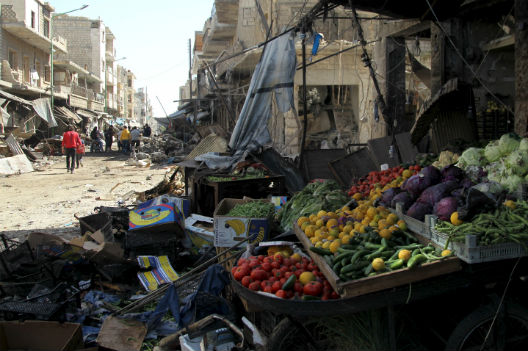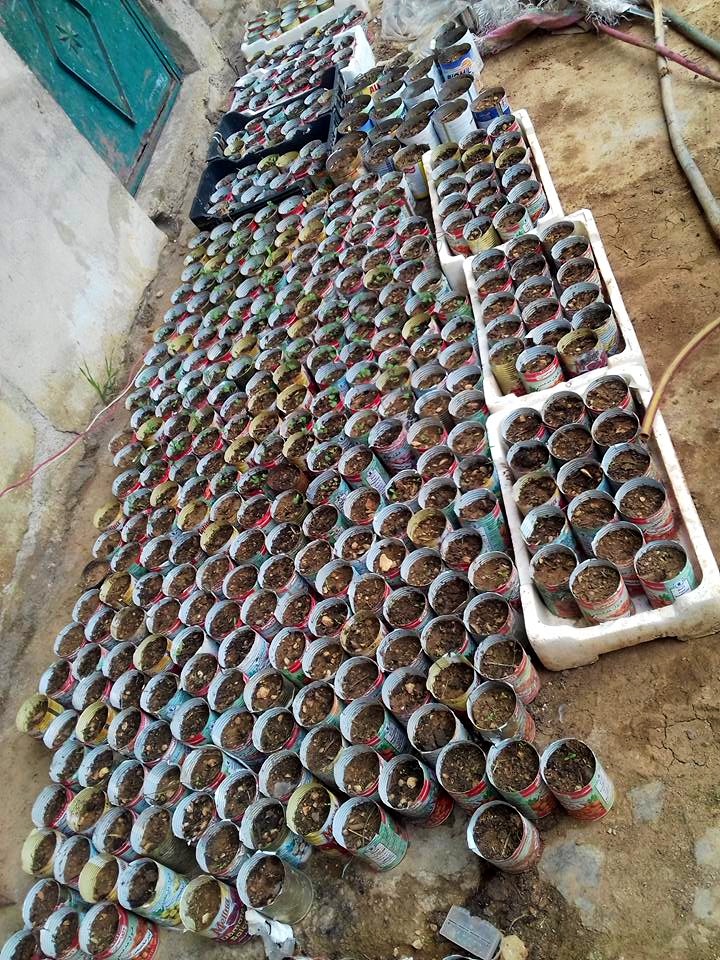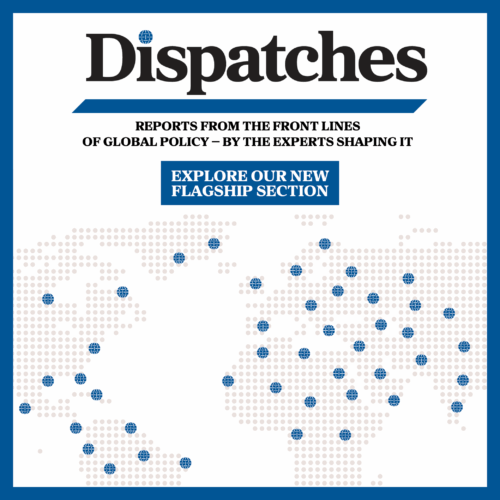 BEIRUT – In Madaya, a mountain village nestled between Damascus and the Syrian-Lebanese border, windowsills used to blossom with roses, jasmine, and the scented geraniums that people might once have used to flavor a delicate syrup for sweets. But now, instead of flowers, the windows are overflowing with cucumbers, tomatoes and zucchini.
BEIRUT – In Madaya, a mountain village nestled between Damascus and the Syrian-Lebanese border, windowsills used to blossom with roses, jasmine, and the scented geraniums that people might once have used to flavor a delicate syrup for sweets. But now, instead of flowers, the windows are overflowing with cucumbers, tomatoes and zucchini.
People from Madaya have always farmed on the hillside that slopes down toward the valley. But one year ago, government forces took back the strategic border town of Zabadani, a key supply point between Syria and Lebanon, in the valley below the village. Since then, Madaya has been under siege by the Syrian government and its ally, the Lebanese Shiite militia Hezbollah; the village’s farmers can no longer access their fields.
“We’ve been farmers from the first day,” says Abu Khalil, nom de guerre of a civil activist and independent citizen-journalist from Madaya. “We used to plant our land. But the siege cut us off from our fields. So we brought boxes and filled them with red soil for planting. We put them on balconies, on verandahs of houses, any place where the sun can reach.”
For the past four years, the Syrian government and its allies have been systematically laying siege to rebel-controlled areas and withholding food from civilians. Sunni militias like the so-called Islamic State and the al-Qaida affiliate Jabhat al-Nusra have also adopted the tactic – a war crime, when used against civilians.
Today, the United Nations estimates that some 590,200 people are officially under siege. But independent humanitarian groups have criticized the U.N.’s classification system, which considers some areas “hard to reach” rather than besieged, for underestimating the severity of the problem. Doctors Without Borders has put the number of Syrians under siege as high as 1.9 million. The initiative Siege Watch estimates that over 1 million people are being slowly, methodically starved in Syria – the overwhelming majority of them by their own government.
But as the sieges have spread across Syria, people in the besieged areas have discovered a secret weapon that’s difficult to detect and almost impossible to defeat: seeds. In many of Syria’s besieged areas, people are turning to urban gardening as a way to feed themselves and break the brutal siege economies that can drive up prices for basic foodstuffs several hundred percent or more.
In Waer, a besieged neighborhood in the city of Homs, people cleared an empty lot full of construction rubble in order to plant a community garden. In Talbiseh, a town outside of Homs still under partial siege, the Makdouseh project – named after a pickled eggplant – is planting almost 500 acres (200 hectares) of tomatoes, eggplants and peppers. And in Madaya, the Bizret al-Khair, or Seeds of Goodness, project distributes small portions of vegetable seeds to about 320 families inside Madaya.
“Under the shadow of siege, and the closing of the roads, we saw [from these stories] that we’d have to rely on ourselves,” says Wafika Hashem, from a family of veteran farmers in Madaya. “And from this followed the idea: we tried to secure seeds by any means possible.”
Getting seeds is not as easy as it sounds. The Syrian government regulates the seeds for all major crops, especially those it considers “strategic,” such as wheat or cotton. In theory, farmers are supposed to get seeds from the Ministry of Agriculture and Agrarian Reform. That’s not possible for people in besieged areas, where checkpoints restrict the passage of goods in and out. But smuggling and bribery are common, thanks to the conflict, and in rebel-held areas people can find ways to get seeds – for a price. In Madaya, zucchini seeds that used to cost around $24 per kilo went up, at times, to $240. “There’s been a lot of exploitation here,” says Hashem. “In a very unnatural, very unacceptable way.”
This kind of profiteering is typical of the war economy that has grown up around the sieges. As the conflict enters its sixth year, the practice of besieging civilians has evolved from a military tactic to a revenue-generating sector in its own right: wealthy traders with connections to the government negotiate exclusive rights to smuggle goods into besieged areas. In return for these lucrative monopolies, they kick back a portion of the profits to the government.
The militias – government and anti-government alike – who control checkpoints in and out of besieged areas also use smuggling as revenue generators. Soldiers or gunmen who man the checkpoints can take up to $2 for every kilo of food they allow in or out; the Wafideen checkpoint into besieged eastern Ghouta became so notorious for this that it is known as Hajez al-Milyon, the Checkpoint of Millions.
With a literally captive market, traders and militias can charge as much as they like for much-needed supplies. On June 7, according to sources inside Madaya, 14 ounces (400g) of powdered milk went for 22,000 Syrian pounds – a little over $100. Just four days earlier, on June 3, it was reportedly much lower, at $70 per kilo; as of July 14, it was $80 per kilo. This kind of day-to-day fluctuation, according to sources from Madaya, is common. The result of this rampant profiteering is that people still starve, even when food is available, because they don’t have the money to buy it.
The siege in Madaya captured international media attention in January, when activists managed to smuggle out horrifying pictures of emaciated adults and weak, hollow-eyed children. After widespread international outcry, the Syrian government permitted four deliveries of international aid. But it was too little, too late; after the first delivery, at least 17 people died of starvation. “They would have needed intensive medical care to revive them from the state of starvation and malnutrition that they were already in,” says Elise Baker, research coordinator at Physicians for Human Rights, which warned last week that the 40,000 people trapped inside Madaya are still in danger of starvation. “No amount of food, at that point, could save them.”
According to Physicians for Human Rights and the Syrian American Medical Society, 86 people have died as a result of the siege on Madaya, 65 of them directly from malnutrition and starvation. (People with severe malnutrition often die of other immediate causes, like illness, that their bodies are too weak to fight.) The aid that has arrived continues to be sporadic, with only four deliveries since January, and nowhere near enough to provide basic nutrients for health.
Vegetable gardens probably can’t stop people from starving. Nor can they bring down the price of commodities like rice, milk or flour. But by giving people an alternative source of calories and nutrients, growing vegetables can make them less vulnerable to both starvation and profiteering. “So many of the Syrian-run NGOs have stepped into the void and filled the gap that the U.N. should be filling,” says Baker. “And that is the reason why some people in Madaya and other besieged towns are able to live.”
Urban gardens can also supply vitamins that aren’t available from the aid deliveries, which contain only dry goods like chickpeas, sugar and cooking oil. “Because of this, we said if we do this idea, no matter the degree of success, it has succeeded,” says Hashem. “At least the small child eats something that has nutrition, other than the usual nutrients that he’s getting from the aid.”

Amrha, a small NGO based in Turkey, provides seeds to residents of Syria’s besieged areas so that they may start their own urban gardens. (Amrha)
Hashem’s project is run by a small NGO called Amrha (or Build It), with support from Alseeraj for Healthcare and Development, a Syrian NGO based in southern Turkey. Amrha supplies the seeds to families for free, on the condition that they don’t resell them. They start their seedlings in boxes, cans – even old food ration tins from the World Food Project. The team of about eight people, as well as 15 new recruits, visits each family to make sure they know how to care for the plants. They grow tomatoes, cucumbers, peppers, eggplants, lettuce, zucchini, pumpkin and green beans. “Whatever surplus you get from your planting, you have to share it with your neighbors, or relatives, or whoever didn’t farm,” says Hashem. “God willing, we can support the whole town.”
Even if they can’t feed the entire town, they can at least give people a reason to hope. “If God permits, if there’s still going to be a siege in the winter,” says Abu Khalil, “we will keep planting.”
Annia Ciezadlo is a Senior Editor at Syria Deeply. She has been living and reporting in the Middle East since 2003, focusing on the politics of food and civilian life during wartime.
This article originally appeared on Syria Deeply, and you can find the original here. For weekly updates about the war in Syria, you can sign up to the Syria Deeply email list.
Image: PHOTO: Produce lies amidst damaged shops after an airstrike on a market in the town of Maarat al-Numan in the insurgent stronghold of Idlib province, Syria April 19, 2016. REUTERS/Ammar Abdullah

